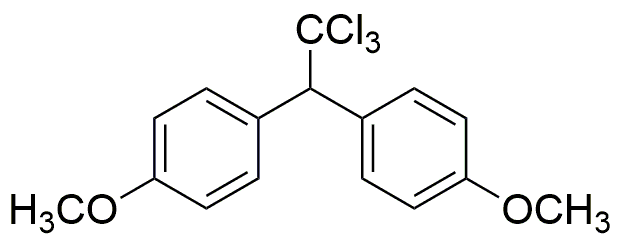Methoxychlor is widely utilized in research focused on:
- Agricultural Applications: It serves as an effective pesticide, particularly for controlling pests in crops. Its ability to target a wide range of insects makes it valuable for farmers looking to protect their yields.
- Environmental Studies: Researchers use methoxychlor to study its effects on ecosystems, particularly in aquatic environments. This helps in understanding the chemical's impact on wildlife and water quality.
- Endocrine Disruption Research: Methoxychlor is often examined for its potential to disrupt hormonal systems in animals. This research is crucial for assessing risks to human health and wildlife.
- Formulation Development: In the pharmaceutical industry, it can be used as a model compound in the development of new drugs, particularly those targeting hormonal pathways.
- Comparative Toxicology: Methoxychlor is utilized in toxicology studies to compare its effects with other pesticides, aiding in the development of safer alternatives for pest control.
Informations générales
Propriétés
Sécurité et réglementation
Applications
Methoxychlor is widely utilized in research focused on:
- Agricultural Applications: It serves as an effective pesticide, particularly for controlling pests in crops. Its ability to target a wide range of insects makes it valuable for farmers looking to protect their yields.
- Environmental Studies: Researchers use methoxychlor to study its effects on ecosystems, particularly in aquatic environments. This helps in understanding the chemical's impact on wildlife and water quality.
- Endocrine Disruption Research: Methoxychlor is often examined for its potential to disrupt hormonal systems in animals. This research is crucial for assessing risks to human health and wildlife.
- Formulation Development: In the pharmaceutical industry, it can be used as a model compound in the development of new drugs, particularly those targeting hormonal pathways.
- Comparative Toxicology: Methoxychlor is utilized in toxicology studies to compare its effects with other pesticides, aiding in the development of safer alternatives for pest control.
Documents
Fiches de données de sécurité (FDS)
La FDS fournit des informations de sécurité complètes sur la manipulation, le stockage et l’élimination du produit.
Spécifications du produit (PS)
Le PS fournit une description complète des propriétés du produit, notamment sa composition chimique, son état physique, sa pureté et les exigences de stockage. Il détaille également les plages de qualité acceptables et les applications prévues du produit.
Certificats d'analyse (COA)
Recherchez des certificats d'analyse (COA) en saisissant le numéro de lot du produit. Les numéros de lot et de lot se trouvent sur l'étiquette d'un produit, après les mots « Lot » ou « Lot de fabrication ».
Numéro de catalogue
Numéro de lot/série
Certificats d'origine (COO)
Ce certificat d'exploitation confirme le pays dans lequel le produit a été fabriqué, et détaille également les matériaux et composants utilisés et s'il est issu de sources naturelles, synthétiques ou autres sources spécifiques. Ce certificat peut être requis pour les douanes, le commerce et la conformité réglementaire.
Numéro de catalogue
Numéro de lot/série
Fiches de données de sécurité (FDS)
La FDS fournit des informations de sécurité complètes sur la manipulation, le stockage et l’élimination du produit.
DownloadSpécifications du produit (PS)
Le PS fournit une description complète des propriétés du produit, notamment sa composition chimique, son état physique, sa pureté et les exigences de stockage. Il détaille également les plages de qualité acceptables et les applications prévues du produit.
DownloadCertificats d'analyse (COA)
Recherchez des certificats d'analyse (COA) en saisissant le numéro de lot du produit. Les numéros de lot et de lot se trouvent sur l'étiquette d'un produit, après les mots « Lot » ou « Lot de fabrication ».
Numéro de catalogue
Numéro de lot/série
Certificats d'origine (COO)
Ce certificat d'exploitation confirme le pays dans lequel le produit a été fabriqué, et détaille également les matériaux et composants utilisés et s'il est issu de sources naturelles, synthétiques ou autres sources spécifiques. Ce certificat peut être requis pour les douanes, le commerce et la conformité réglementaire.

